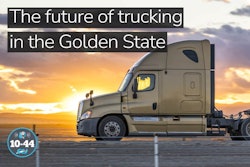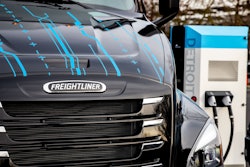On March 31, California received waivers from the Environmental Protection Agency that allow the state to require half of heavy trucks sold in the state to be zero emission by 2035. On last week’s 10-44, we heard from CALSTART on the air quality benefits of the rules and why California wants to self-regulate to a higher standard than the EPA.
Joining Jason and Matt this week is Priyesh Ranjan, CEO of AI-enabled supply chain platform Vorto, who talks about how the regulations impact the industry, particularly when it comes to small fleets and owner-operators, which represent the vast majority of capacity in the trucking.
Contents of this video
00:00 Zero-emission requirements, small fleets and owner-operators
02:35 Electrification and disruption
06:33 Infrastructure to support electric or alt-fuel trucks
08:07 Zero-emission requirements to register a truck
11:02 Potential impacts of new rules in California
12:21 Ways smaller fleets and owner-operators can prepare for zero-emission regulations
Jason Cannon
This week's 10-44 is brought to you by Chevron Delo 600 ADF ultra-low ash diesel engine oil. It's time to kick some ash.
Matt Cole
What California's new zero-emission requirements mean for trucking and how fleets can start thinking about preparing.
Jason Cannon
You're watching CCJ's 10-44, a weekly webisode that brings you the latest trucking industry news and updates from the editors of CCJ. Don't forget to subscribe and hit the bell for notifications so you'll never miss an installment of 10-44.
Hey, everybody, welcome back to the 10-44. I'm Jason Cannon and my co-host on the other side, as always, is Matt Cole. At the end of March, California received waivers from the Environmental Protection Agency that lets the state require half of all heavy truck sales sold in that state to be zero emissions by 2035. On last week's 10-44, we heard a lot from Cal Start on California's right to self-regulate its air quality and what it means for big fleets in and around the state.
Matt Cole
But what about the impacts on trucking, particularly when it comes to small fleets and owner-operators, which represent the vast majority of capacity in the industry? Joining us this week on the 10-44 is Priyesh Ranjan, CEO of AI-powered supply chain company Vorto and its 5F logistics platform who talks about what California's push to zero might mean for the industry over the next decade or so.
Priyesh Ranjan
The way to think about this is we have two verticals. One of them is an autonomous supply chain platform where Vorto basically focuses on, think of a triangle, one edge of the triangle are shippers, the other edge of the triangle are suppliers of different products, and then the third edge of the triangle are trucking companies, carriers who move those products. And the platform basically automates predicting the demand of the products that the shipper needs, it automatically sources it from the suppliers, then it automatically tenders it and dispatches it to the driver and it basically automates from an end-to-end from predicting the demand to sourcing all the way down to logistics.
So that's one of our verticals. The second vertical is a freight platform where we connect owner-operators, these are truckers with about 20 trucks or less, which is about 96% of America's trucking, with shippers, and that's called 5F. Kind of the main aspect of those waivers are they're creating a transition plan where at a certain point, when new trucks come in, they have to be electric trucks, everybody to go register their trucks now, correct? Which are diesel trucks. And then as time goes by, when you're registering a new truck, it'll have to be an electric truck. That's the simplest way to understand it.
Jason Cannon
Priyesh says that while the two sides of this argument are really far apart, he thinks there is a happy middle ground that can be found.
Priyesh Ranjan
I can see both sides. There is one side that is obviously heavily focused on driving the electrification and then there's the other side that may find this incredibly disruptive to day-to-day business. And I think there is a happy medium here with regards to what's happening. And the reason for that is a lot of this conversation that is happening is happening in the short-haul industry. So in the drayage industry, in the localized-freight industry, and there probably is a faster path to electrification in those industries because infrastructure can be localized.
A trucker can do two, three shipments a day and then charge their truck in the evenings. So while it may seem a little disruptive, while it may seem a little bit of a radical decision, it actually, it might pan out to be a productive decision. Obviously, you always want the free market to create change, right? Because then all the economic incentives get lined up much better than through regulations. But I think there is a convergence point taking place where the readiness of electric trucks today of wherever the industry is, the learnings that we have on how to build infrastructure, especially from the car industry, will help in the urbanized, localized areas.
Where I think it'll take longer will be the long-haul industry over the road, where you'll have to build infrastructure all across the country. I see this as a positive, but obviously, things have to shake out, just simple things that have to shake out, is like the total cost of ownership of these trucks is going to be higher than diesel trucks, even though the maintenance and the optics will be lower, the fuel and stuff like that because these are electric trucks, as you know, 96% of America's trucking are these small truckers.
So they will have to find ways to stomach that, that higher purchase cost, so to speak. And then it all comes down to efficiency. If there is enough efficiency in the system where they can do enough shipments in a day, all of this falls perfectly. When the efficiencies don't exist, that's when the adoption takes longer and that's when regulations have to be flexible in changing dates, changing timelines, just because the unit economics doesn't support it, and just having a deadline doesn't solve anything because at the end of the day, the money has to be spent by these small truckers, these entrepreneurs, small owner-operators.
Matt Cole
While there's still 12 years before the first zero emission sales deadline in California, there's a lot of work to do in that time, particularly when it comes to infrastructure to support electric or alt fuel trucks. We'll hear more on that after a word from 10-44 sponsor Chevron lubricants.
Jason Cannon
Protecting your diesel engine and its after-treatment system has traditionally been a double-edged sword. The same engine oil that is so essential to protecting your engine's. Internal parts is also responsible for 90% of the ash that is clogging up your DPF and upping your fuel and maintenance costs. Outdated industry thinking still sees a trade-off between engine and emission system protection and Chevron was tired of it, so they spent a decade of R&D developing a no-compromise formulation.
Chevron lubricants developed a new ultra-low ash diesel engine oil that is specifically designed to combat DPF ash clogging. Delo 600 ADF with OMNIMAX technology cuts sulfate ash by a whopping 60%, which reduces the rate of DPF clogging and extends DPF service life by two and a half times. And just think what you can do with all the MPGs you're going to add from cutting your number of regions. The Delo 600 ADF isn't just about after-treatment, it provides complete protection, extending drain intervals by preventing oil breakdown. Before, you had to choose between protecting your engine or your after-treatment system, and now you don't. 600 ADF from Delo with OMNIMAX technology, it's time to kick some ash.
Priyesh Ranjan
I'm following the developments that are happening in this industry that probably do not have a good appreciation on what does the supply chain look like from a throughput perspective for electric trucks. Obviously, the infrastructure piece is very easy to grapple your mind around just because we saw it in the car industry. Today, there's so much more infrastructure in the electric car industry as compared to when Tesla came out, for example. So that's very easy to grapple.
Obviously, the car industry also went through quite a growing pain with production targets. There were lesser players doing it at the time, obviously now you can see so many companies are doing it, very established companies are doing it that have the know-how or they have learned through the blind corners over the years. I don't know how to predict or I probably am less aware, I need to probably study the market a little bit more on what's happening in the electric truck world with regards to companies that are bringing this out. What are their production targets? Are they on target? Are they behind? What's their ramp plan?
So a lot of additional things have to come in place versus just charging stations, but the positive is I would be surprised if the growing pains would be the same as the car industry. There's a lot that has been learned through the car industry. These are very different types of vehicles, but there's still a lot that has been learned. So I would imagine that even if there are disruptions or there is a slowness of a lot of these trucks showing up into the market, it shouldn't be as bad as the journey that we went through when we did it for the first time in the car industry.
Jason Cannon
Now, it's noteworthy that California is only targeting new truck sales with its latest EPA waivers, but it's likely, if not guaranteed, that eventually there will be a zero-emission requirement to register a truck to operate in the state. Priyesh believes that will still be a ways down the road, though.
Priyesh Ranjan
I think there definitely will be a long tail just from unit economics perspective. There'll have to be a long tail where you take, what do you do with these assets that people already have? There's going to be a long tail. But one of the things to understand and to figure out as an industry is the trucking industry is incredibly cyclical. If you're an owner-operator, you have certain cycles where you make money, you have certain cycles where you barely break even, and then you have certain cycles where you absolutely don't make money.
When you accumulate those cycles, you're trying to figure out cash-on-cash returns, and that's a very challenging aspect in the trucking industry. Demand spikes, new owner-operators flush the market, so a lot of them come in. So now you get into an oversupply state, now you have to either hope for demand to come up or you have to hope for supply to come off, and those cycles are very long. We are right now in an over-surplus for trucking for the last few quarters. As demand came up during COVID, we had record numbers of small owner-operators joining the trucking industry.
As COVID faded off, consumer behaviors changed, you ended up having very large I inventories with all these retailers, so the transportation needs kind of dropped, and now you're sitting in this oversupplied market where it only rebalances as supply comes off, which takes about a year or so because unfortunately, supply coming off is truckers going bankrupt. It's kind of unfortunately how supply comes off in this kind of market. Understanding those long cycles is probably something that we probably don't have an appreciation and the regulations will find headwinds because unit economics will not support them.
Having said that, that's not doom and gloom. I think that's where the regulations may need to be a little bit more flexible and understand the need for a long tail so that you don't have such crazy disruptions when you're creating a situation like this and unit economics don't work for entrepreneurs. And now, certainly, you can get into a world where you have a very heavy supply shortage, which means freight costs go up, which means, okay, while you're solving an issue for carbon emissions, now you're drastically impacting the economy of California. So I think that's where probably the awareness is a little bit lower across all of us trying to figure it out together, and that's kind of where we'll need to figure it out how to size that tail.
Matt Cole
Looking ahead, Priyesh sees a couple of potential impacts these new rules will have in California.
Priyesh Ranjan
The one thing that I'll be very interested to see here is there are two impacts that that is going to create. One is either it's going to create incredible fluctuation in the freight pricing in the market because of it being a little bit of... If the economic incentives don't align very well. Or it is going to be what everybody's trying to achieve, which is suddenly you start seeing more electric trucks and you see more electrification.
So I think you are probably going to first see some jolts in supply and demand shortage, more supply shortage, so to speak, right? You will see some flexibility and regulations of like, "Okay, this is having consequences that are not worth bearing." And then that pivot will have to happen. That flexibility of, "Okay, let's go move it this way. Let's go create a regulation that works in this manner," but you would only understand those things once you get into it.
You can make all these assumptions that you want to make right now, but as the dates hit, the reality hits, are you learned more than you probably didn't assume? And that new learning allows you to pivot again. And if the regulations can be flexible about that and people can think about this pragmatically, we probably will get to the same goals maybe with a little bit longer tail, but with lesser disruption to the Californian economy.
Jason Cannon
While larger fleets are going to have more flexibility to adapt to those new regulations when they take effect, Priyesh says there are some ways that smaller fleets and owner-operators can start to prepare for the future of zero-emissions regulations.
Priyesh Ranjan
For owner-operators, one of the things to really think about is traditionally, at least from the way I have noticed, owner-operators have gone into trucking and have chased the money. And I would break trucking into three types, short haul, localized trucking, you sleep at home every day, medium haul, you're probably away from home for a day or two, and then you come back, long haul, you're away for about two weeks, 10 days to two weeks.
And whenever you start getting into this world where you need to have a diversified fleet of diesel trucks, of electric trucks, of more expensive diesel trucks with the regulations on tail pipe and stuff like that, it's very important to really start thinking of a diversified portfolio of where to work, and start understanding the unit economics of, "Okay, if I had a few electric trucks, which markets would I put that in? Would I put that in long haul, short haul, medium haul? If I would go into short haul, which markets would I go into?"
The same way for diesel trucks, for more expensive diesel trucks. If you really start thinking about positioning the right assets in the right market, you actually not only are able to have a diversified fleet, but you're also able to deal with the cyclicality because all those three markets go through cyclicality almost in a very disjointed way. We have seen a massive dip in long-haul freight cost today and relatively lower depth in the short-haul world.
But on the reverse, when long haul got hot, the revenue to be made in long haul was much higher than the revenue to be made in... From a net revenue perspective. So that's probably the recommendation to owner-operators, to look at this as a business, to really understand the market segments and understand the unit economics in all these three segments, the short, medium, and long. And then, start figuring out how to place assets because certain assets have to be retired, certain assets don't need to be retired, they just need to be mobilized into new markets because all states, all industries are going to have their own journey to electrification.
And that basically allows you to really think about it from a big-picture perspective and say, "Okay, I get it. Obviously, everything is not going to go electric overnight, so instead of getting rid of this truck, I would rather mobilize this into this market, bring in new trucks in this market," and if you do it correctly, it actually works.
We have a lot of owner-operators on our platform that operate in multiple markets, not in just geographical markets, but we are in multiple industries. And we notice how they very logically and cleverly mix their fleet across the oil and gas industry, the consumer good industry, the trade industry, and it gives them that diversified portfolio today with diesel trucks, but it'll also give them the diversified portfolio with a diversified fleet, if that makes sense.
Jason Cannon
That's it for this week's 10-44. You can read more on ccjdigital.com. While you're there, sign up for our newsletter and stay up to date on the latest in trucking industry news and trends. If you have any questions or feedback, please let us know in the comments below. Don't forget to subscribe and hit the bell for notifications so you can catch us again next week.











